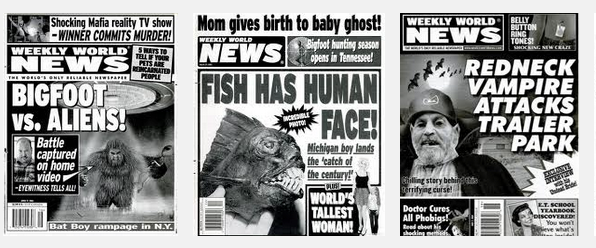Get BigFoot to Work for Free (and 12 Other Ways to Write a Killer Headline)
We’re willing to wager fully 92% of shoppers try to entertain themselves in long supermarket lines by browsing the great headlines from the tabloids. Just for a laugh, here’s a screenshot of some yummy ones from a Google image search on “weekly world news covers“:
Sensation sells. While you might not employ BigFoot in your headline as we’ve done, you can still get the tabloid phenomenon to work for your copy. Below are some ideas to get the gray matter churning when you’re stuck or want to wow.
The desire to create that one heroic headline–one that stops all traffic with a grand, screeching halt and then compels the reader forward–is the holy grail of writers. Resist the temptation to get hung up on it. You can either start your article with a headline and build the content to fill it, or you can create your content, flesh out your ideas, and then find a headline that suits. Probably the best course for most purposes, whether blog post, white paper, or full-fledged novel, is a combination of the two. Think of the grand idea that you want to pitch, create your content, and then try several headlines. Narrow it down to two or three favorite headlines and then pick it apart if you like, making sure every word is powerful and suited to the headline.
Occasionally the location where you’re entering your headlines, such as an email campaign template or online press release form, etc., will govern how many characters you can use, and you will be forced to compress your headline into a short and sweet punch. Twitter, by the way, can be a great training ground for efficient word choice. Alternatively, longer headlines, in the appropriate surroundings, can lure people in to your copy with a one-two combo more irresistible than happy hour with free appetizers.
-
Use a number and promise a fascinating list. Okay, this one is getting pretty trite by now, but it still works. Tip: Use a low, odd number, like “Five Reasons to ….” or “7 Ways to…” The meme “7 Ways To Scare Your Roommate” would not have taken off, it had been named the duller “Ways to Scare Your Roommate.” Sometimes you will see a blog post with a title like “89 Don’t-Miss Plug-Ins for Your Blog” and if you’re us, you’ll cringe and shrink away from the overwhelm that is sure to follow.
-
Make it a solution headline, that promises to fix a problem. Great examples, again courtesy of the supermarket checkout-lane, include “Secret to making the perfect hard-boiled egg” or “10 minutes to calm: de-clutter and de-stress.”
-
Use the reporter’s standbys. Include one of these content leading words in in your title: Who, What, Where, How or Why.
-
Use outlandishly colorful, zestful language. You can try alliteration or consonance.
-
Promise what no one can refuse, and what everyone needs. Think and Grow Rich and How to Win Friends and Influence People are two perennial best sellers with a simple, universal promise.
-
Tease the reader. Who hasn’t opened an email that says “Why you don’t want to read this now” ? A reverse-psychology gotcha!
-
Use humor, and tempt with the promise of more to come in the copy. DO consider, though, that if your headline is designed for SEO purposes, Google’s search algorithms can’t score for creativity. However, if the article is eminently sharable through Twitter because of the hot sizzle factor, gets a gazillion “Likes” and comments, that should trump SEO card.
-
Ask a question. Who could resist wondering if the forever-solution might just really be lurking under an article with the header, “Need a quick way to ensure you never forget your keys?”
-
Surprise and startle the reader with a crazy, hard-to-fathom fact.
-
Surf the tabloids at the supermarket, and note which articles “pop” at you, tempting you to do an impulse buy to read the content. Also check out your favorite mags that appeal to you (assuming you do read things beside The National Enquirer) and figure out which article held promise and why.
- Try a two-part headline. For example, Prevention magazine features four headlines, each with a two-part premise: “Get the body you want, and the calm you crave”; “Hidden dangers in grains; Find out if you’re at risk”; “Double your happiness; Just do this.” Each article promises a secret solution inside. We all want things easier, faster, tastier. Perennial Gardening lures readers with the headline: “No-Fail Classics; Plant Them and Forget Them.”
-
Consider whether punctuation, bolding, or strategically varied fonts will be available within the headline to make certain elements of the headline stand out. Exclamation points are usually a no-no in email headers as they can trigger spam filters, but can be used to good effect in other places such as in interior headers of newsletters.
Bonus, for a “baker’s dozen”:
Don’t by shy about getting some feedback from other readers, co-workers and editors you trust. Collaborating early can save you brain drain.









Devan Ciccarelli
April 30, 2013 at 12:42 pm
Well said, Ann!
I was recently searching for some tips on headline writing, and you guys nailed it. Great tips and I love the headline!
Ann
April 30, 2013 at 12:49 pm
Thanks for stopping by, Devan, and the note. Hope to read your copy that you’re brainstorming a headline for. Stay in touch!
Ann
Sasha
May 6, 2013 at 11:38 am
Great article
Ann
May 6, 2013 at 12:37 pm
Thanks, Sasha, and thanks for your help with the blog gravatar too!